VIRUS UPDATE: Positive cases continue to fall in Marina Alta
Nationally, the 14-day IA rate has dropped almost a quarter in the last week as the so-called ‘fifth wave’ of infections slows down.
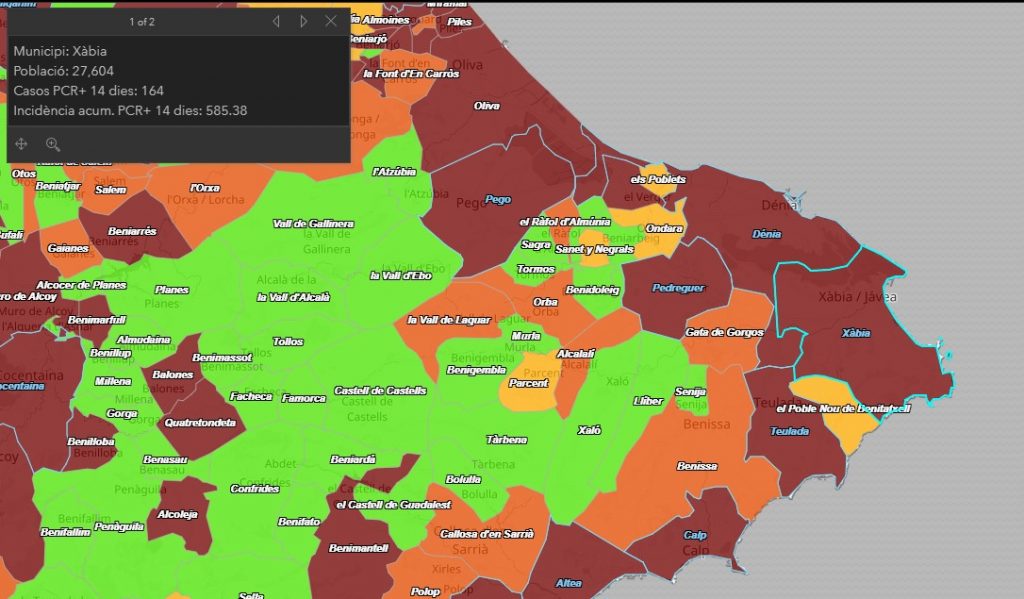
Tuesday 17th August 2021 – Compiled by MIKE SMITH
Xàbia
The total number of positive coronavirus cases detected by PCR test in Xàbia has climbed to 2,192, according to the latest update from the regional health ministry, a rise of 40 since the last update on Friday 13th August.
The municipality’s 14-day IA rate, a measure of the speed at which the virus moves through the population, has dropped to 585.38 cases per 100,000 inhabitants and the town remains in the ‘Extreme Risk’ alert level.
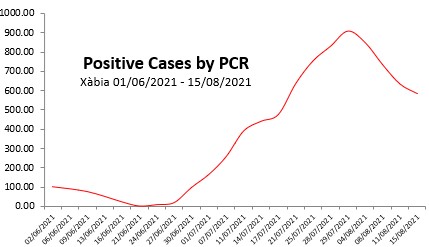
There have been no new deaths in Xàbia since late March and the number remains at 12.
Marina Alta
There have been 683 new positive cases detected by PCR test in the Marina Alta in the past 14 days and the region’s 14-day IA rate has dropped to 400.29 cases per 100,000 inhabitants and it remains in the ‘Extreme Risk’ alert level. The detection of positive cases of COVID-19 in the region has dropped by 50% in the past two weeks.
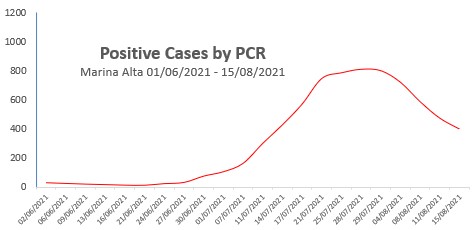
There have been 0 new deaths since the last update and the region’s toll remains at 205.
The total number of positive cases since the pandemic began is now 13,888 since the last update on Friday 13th August, a rise of 188.
- 82 – Dénia
- 40 – Xàbia
- 29 – Calp
- 9 – Teulada-Moraira
- 8 – El Vergel
- 5 – Benissa
- 4 – Gata de Gorgos; Pedreguer
- 3 – Pego
- 2 – Ondara
- 1 – Poble Nou de Benitatxell; la Vall de Laguar
Municipalities at EXTREME RISK level
Calp; Dénia; El Vergel; Pedreguer; Pego; Teulada-Moraira; Xàbia.
Municipalities at HIGH RISK level
Alcalalí; Benissa; Gata de Gorgos; Orba; el Ràfol d’Almúnia; la Vall de Laguar.
Municipalities at MEDIUM RISK level
Els Poblets; Ondara; Parcent; el Poble Nou de Benitatxell; Sanet y Negrals.
Municipalities at LOW RISK level
None.
Autonomous Regions at NEW NORMAL level
Adsubia; Beniarbeig; Benidoleig; Benigembla; Benimeli; Castell de Castells; Llíber; Murla; Sagra; Senija; Tormos; la Vall d’Alcala; la Vall d’Ebo; la Vall de Gallinera; Xaló.
Spain
Spain’s 14-day IA rate is 415.90 cases per 100,000 inhabitants, a drop of of almost a quarter in the last week, but the country remains in the ‘Extreme Risk’ category.
The Positivity Rate, the measure of how many coronavirus tests return positive, has dropped to 12.53%. A value of 5% or less indicates that transmission of the virus is more or less under control.
Hospitalizations
According to the latest report from the CCAES, there are 9,356 hospitalized due to COVID-19 across Spain, a drop of 12% on two weeks ago, of which 1,931 have been admitted to ICU wards, a rise of 4% on two weeks ago. The percentage of beds in general wards occupied by patients suffering from COVID-19 is 7.97% whilst the percentage of beds in ICU wards occupied by COVID-19 patients is 20.96%.
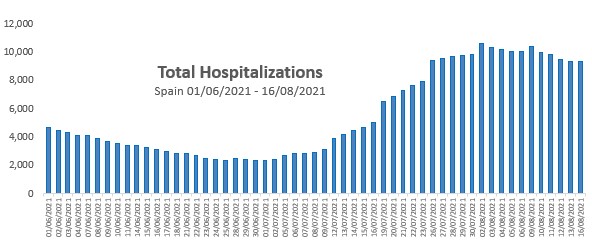
Cataluña still leads the way in hospitalizations, with 2,249 people currently in hospital due to COVID-19, of which almost 44% have been admitted to ICU wards for extreme cases. The autonomous region of Madrid is not far behind, with 1,836 people in hospital, of which 33.40% are in ICU wards, whilst Andalucia has 1,417 people in hospital, 13.14% of which are being cared for in ICU wards.
In the Comunidad Valenciana, 639 people are currently hospitalized, according to the latest CCAES report, with 13.58% of ICU ward capacity occupied by those suffering from the extreme effects of COVID-19.
Deaths
The country has suffered 242 deaths in the past seven days, a rise of 17% when compared to two weeks ago. The national death toll to 82,595 since the pandemic began.
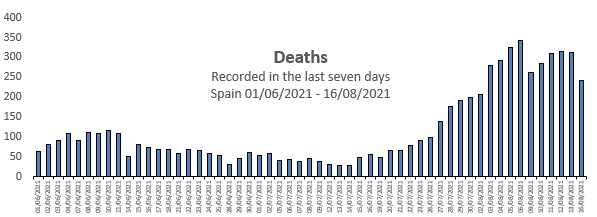
Regional Data
Across Spain, the rise of infections continues to slow and 17 of the 19 autonomous regions have reported IA rates lower than they were two weeks ago, the remaining two being the autonomous cities of Ceuta and Melilla on the coast of North Africa.
The Balearic Islands still lead the way with a 14-day IA rate of 540.07, although it has dropped some 42% in two weeks. La Rioja is not far behind (499.20), although their rate is 36% lower than two weeks ago, whilst the autonomous city of Melilla is third with a rate of 496.12, 72% higher than two weeks ago.
The Comunidad Valenciana’s rate, currently 353.11, has dropped by over 40% in the past two weeks and it remains the autonomous region with the second lowest rate in mainland Spain behind Asturias, where the rate has more than halved in the past fortnight to 224.978.
Autonomous Regions at EXTREME RISK level
Andalucia; Aragón; Baleares; Canarias; Cantabria; Castilla y León; Castilla-La Mancha; Cataluña; Ceuta; Comunidad Valenciana; Extremadura; Galicia; La Rioja; Madrid; Melilla; Murcia; Navarra; País Vasco.
Autonomous Regions at HIGH RISK level
Asturias.
Autonomous Regions at MEDIUM RISK level
None
Autonomous Regions at LOW RISK level
None
Autonomous Regions at NEW NORMAL level
None
How does Spain compare to the rest of Europe?
Top 20 table based on new confirmed COVID-19 cases per 1 million population on August 12th 2021.
- Montenegro (582.52) ↑
- Kosovo (502.09) ↑
- Cyprus (454.47) ↓
- United Kingdom (425.80) ↑
- Republic of Ireland (356.20) ↑
- Greece (309.10) ↑
- Monaco (298.50) ↑
- North Macedonia (294.37) ↑
- Iceland (283.83) ↓
- Spain (279.56) ↓
- Turkey (261.77) ↓
- Portugal (229.89) ↑
- Switzerland (228.47) ↑
- Liechtenstein (221.01) ↑
- Andorra (218.17) ↑
- France (212.49) ↓
- Estonia (208.06) ↑
- Lithuania (197.42) ↑
- Denmark (174.79) ↑
- Belgium (166.41) ↑
↑ = infection spread rising
↓ = infection spread dropping
Source: ourworldindata.org
Vaccination (15.08.21)
Spain has administered 61,418,303 doses of vaccine, which is 96.2% of those which it has already received (63,828,592). A total of 29,794,008 people have completed the recommended course, which is 70.7% of the total of the population which is to be vaccinated (42,119,827) or 62.8% of the total population of Spain.
According to the latest data provided by the health authorities, 93.4% of people aged 40 and over in Spain have received at least one dose, with 90.3% having completed the recommended course.
The Comunidad Valenciana has administered 6,358,785 doses of vaccine, which is 97.1% of the total which it has received (6,546,180). A total of 3,057,838 people have completed the recommended course, which 68.1% of the population which is to be vaccinated (4,488,459) or 60.5% of the total population of the Comunidad Valenciana.
According to the latest data provided by the health authorities, 93.9% of people aged 40 and over in the Comunidad Valenciana have received at least one dose, with 91.6% having completed the recommended course.
The newspaper El Pais has reported that it is unlikely that the Spanish government will reach its target of 70% of the population fully vaccinated by the end of the August as vaccination campaign slows down due to several factors, such as summer holidays, the lower perception of risk from COVID-19 among the younger age groups, and the scale of the fifth wave which has meant that those infected will have to wait several months before they can receive their shots.
How does Spain compare to the rest of Europe?
Top 20 table based on percentage of population fully vaccinated.
- Malta (91.65%)
- Iceland (74.82%)
- San Marino (69.83%)
- Belgium (66.05%)
- Denmark (65.34%)
- Portugal (64.72%)
- Spain (63.15%)
- Republic of Ireland (62.36%)
- Netherlands (59.80%)
- United Kingdom (59.77%)
- Italy (57.05%)
- Hungary (56.94%)
- Germany (55.82%)
- Austria (55.46%)
- Cyprus (55.26%)
- Luxembourg (54.80%)
- Greece (52.82%)
- Liechtenstein (52.51%)
- France (51.79%)
- Lithuania (50.10%)
Source: ourworldindata.org
LINKS
- Actualización nº 441. Enfermedad por el coronavirus (COVID-19). 16.08.2021
- GIV COVID-19 Gestión integral de la vacunación COVID-19
- COVID-19 C. Valenciana: Monitoratge de la situació



